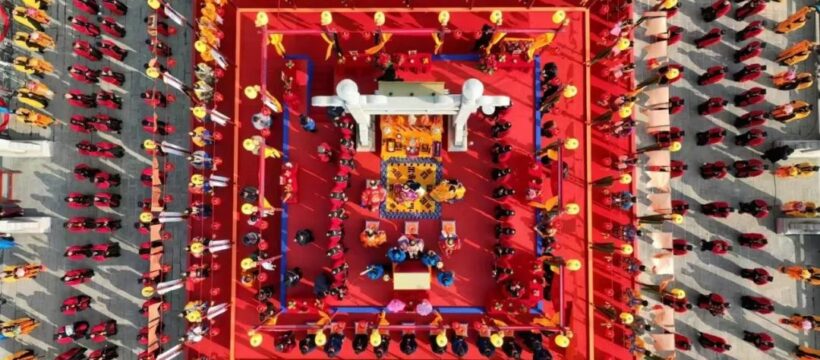The Daoist ceremony is extremely exquisite and complex, considered the most in the world, with a rich tradition dating back to the Eastern Han to the Wei, Jin, and Southern and Northern Dynasties, spanning over approximately 1,900 years, like the vast and flowing waters of the East Sea. The ceremony can be mainly divided into fasting (zhai) and offering (jiao).
According to the ancient method of Du Guangting, a Daoist master from the Tang Dynasty, Daoists should observe a set of twenty-seven fasting rituals and forty-two offering ceremonies.

Fasting and offering are closely connected, essential methods for self-cultivation, benefiting society, and enhancing blessings. Although fasting and offering are inseparable, they are easily confused, and in later contexts, the terms are used interchangeably. Taking advantage of the 30th anniversary of the restoration of the Qianyuan Guan on Mount Maoshan, the ‘Luo Tian Da Jiao’ grand ceremony is held as a righteous and virtuous event, serving as a short essay for the understanding of those interested.
Jiao is the worship of the gods in the heavenly realms, but it fundamentally differs from Confucian “sacrifice.” Sacrifice in Confucianism involves the slaughter of animals, offering pigs, cattle, and sheep, whereas Daoism, guided by compassion, upholds the principle of kindness and only offers fruits and vegetables to the Three Realms’ holy beings.


Fasting is not just about abstaining from meat; it is a crucial aspect of cultivation and tranquility. Its initial goal is to ‘subdue one’s nature and close the gate of the spirit.’ Fasting can be divided into various types, such as supply fasting, festival fasting, extended fasting, and pure fasting, reaching the state described as ‘heart fasting’ in the Zhuangzi.
However, the state of ‘heart fasting’ is lofty and not easily attained in an instant. Therefore, external ‘fasting methods’ are employed to facilitate the enlightenment and elevation of the inner world. The establishment of ‘fasting methods,’ as explained in the ‘ Dongxuan Lingbao Fasting advocates the ritual of lighting candles, admonishing and punishing, and making wishes with lamps,’ is based on the idea that human behavior, language, and spirit can deviate from the true path, and methods such as worship, chanting scriptures, and contemplation are used to ‘replace’ these deviations, making them pure and focused to align with the true path.
Based on these theories, practitioners choose specific auspicious days to go to famous mountains and sacred places to perform ceremonies. Through worshiping deities, reciting scriptures, and contemplation in accordance with the prescribed methods, they undergo this practice to refine their minds, identify their beliefs, and purify themselves, continuously elevating their cultivation, qualities, and realms.
The establishment of ‘fasting methods’ requires certain standards, known as ‘ke’, primarily based on the ‘Tai Zhen Ke,’ ‘Ming Zhen Ke,’ and ‘Meng Zhen Ke.’ Those who perform ‘fasting methods’ are required to provide precious offerings, such as silk, golden dragons, golden scripts, and jade discs. These offerings are eventually submerged in rivers or buried at mountain peaks as ‘tokens’ to form a covenant with the deities, and the grade of the ‘token’ is related to the social status and personal blessings of the organizer.

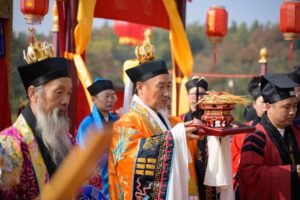
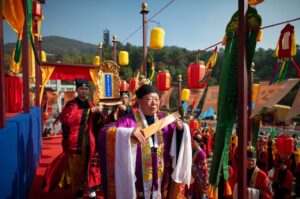
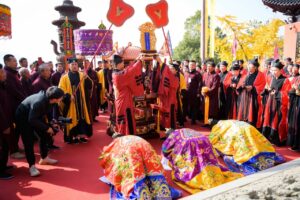
According to the scale of the ‘fasting methods’ set in the ‘Guling Baojing,’ it can be divided into the Upper Yuan Golden Fasting, Middle Yuan Jade Fasting, and Lower Yuan Yellow Fasting. The first two are held by emperors and ministers, while the ‘Yellow Fasting’ can be conducted by common people. The general process of the three ceremonies is similar, but there are differences in the consumption and grade of the ‘tokens.’
In terms of process, whether it is the Golden Fasting, Jade Fasting, or Yellow Fasting, they all follow the three major sections: ‘1. Preparatory – 2. Fasting at the three appointed times – 3. Dispersing the altar and performing the offering.’
‘Preparatory’ is the preparatory stage, and ‘Fasting at the three appointed times’ is also called ‘Three worships,’ imitating the grand ceremonies held in the Purple Palace of the Great Luo Heaven at three specific times each day: Yin, Wu, and Xu. The purpose is to gather the thirty-two heavenly emperors to worship the Primordial Heaven.
The ceremony is based on the ‘Lingbao Nature Fasting,’ refined by Daoist masters such as Zhang Wanfu and Du Guangting from the Tang Dynasty, and further compiled by Zhou Side in the Ming Dynasty into the ‘Shangqing Lingbao Lingjiao Jidu Jinshu.’ By the Ming Dynasty, the ceremony was already well-established and rich.
The ‘Three Worships’ aim to pay respects to the holy truths. In the process of pilgrimage, practitioners cultivate reverence and gratitude, emphasizing repentance for past mistakes. The vision is to achieve a societal vision of ‘protecting against calamities, ensuring the longevity of the heavens’ and a personal vision of ‘ascending to the Dao and merging with the true Dao.’
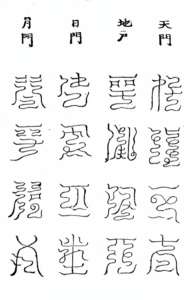
The main sections of the ‘fasting methods’ include: entering the household and burning incense, purifying the spirits, kindling the furnace, opening the sacred, proclaiming the command, chanting scriptures, worshiping the ten directions (or repentance/formula chanting), repentance, three openings and three salutes, making vows, rekindling the furnace, and exiting the hall with praise. This is a summary of the process of the ‘fasting methods.’
The final ‘dispersing the altar and performing the offering’ is to express gratitude to the deities for their protection during the ‘Three Assemblies.’ At the same time, it is to ‘speak of merits’ for the lower-ranking celestial beings and officials (asking for promotion to higher positions in the heavenly realms), also known as ‘speaking of merits and performing the offering.’ In this context, ‘jiao’ means gratitude and thanks, expressing sincere gratitude to the gods through offerings and rituals.
However, it’s important to note that after a long time of contextual confusion, in later generations, the term ‘打醮’ (‘da jiao,’ lit. ‘striking jiao’) is commonly used to refer broadly to all large-scale ritual activities. In fact, every ‘打醮’ encompasses both fasting and offering aspects.
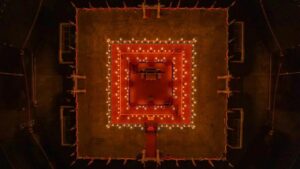
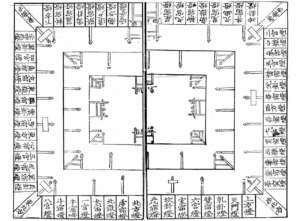
What is ‘Luo Tian Da Jiao’?
‘Luo Tian Da Jiao’ is not the martial arts arena depicted in later comics but rather a high-standard, large-scale event that worships deities above and aids wandering spirits below, benefiting both the living and the dead, accumulating great merit.
According to the records in ‘Dao Men Ding Zhi,’ after the conclusion of the Golden Fasting, the ritual of ‘dispersing the altar and performing the offering’ involves respectfully inviting 3,600 deities to receive offerings, known as the ‘Pu Tian Da Jiao.’ After the Jade Fasting, 2,400 deities are invited, termed the ‘Zhou Tian Da Jiao.’ Upon the successful completion of the Yellow Fasting, an invitation is extended to 1,200 deities for the ritual, referred to as the ‘Luo Tian Da Jiao.’
Here, ‘Luo Tian’ refers to the ‘Dai Mi Luo Tian’, the highest realm above the Three Realms and Four Fan Realms, described in the ‘Lingbao Jing’ as the ‘realm above the Three Realms, vast and great Luo.’ It is the realm of ‘Fan Qi Mi Luo,’ which gives birth to the universe.
At the same time, ‘Luo Tian’ also implies ‘gathering gods from heaven, earth, sea, mountains, and spirits.’ The invited 1,200 deities cover major sacred beings from the Three Clear Heavens, Four Fan Heavens, star realms, Three Realms, Four Mansions, Yang Realm, Water Country, Underworld, and other Sovereigns in the ‘Three Mansions.’
The establishment of the ‘Luo Tian Da Jiao’ is to express ‘sincerity and trust’ through tangible material offerings after the Yellow Fasting, and ‘submitting a dragon and presenting a scroll’ to pledge allegiance to mountains and rivers. It is an expression of heartfelt gratitude to the deities, praying for national prosperity, peace for the people, favorable weather, abundant harvests, and overall peace in the world.
Historically, the documented ‘Luo Tian Da Jiao’ can be traced back to the 2nd year of Qianyuan during the reign of Emperor Suzong of the Tang Dynasty (759), where the grand ceremony was held in front of the three halls of the Daming Palace. That night and the following morning, a dragon was seen on the imperial throne, leaving scales and footprints all over the bed, providing evidence to the courtiers.
In the late Tang Dynasty, Du Guangting’s “Guang Cheng Ji” included the “Luo Tian Jiao Yue Du Ci,” “Luo Tian Jiao Taiyi Ci,” and “Luo Tian Intermediate Three Emperors Jiao Ci.” It explicitly mentioned the “repair of the Yellow Fasting Treasure Fasting and the preparation of the Luo Tian Grand Jiao,” indicating that such rituals had a certain influence during the Tang Dynasty.
In the “Continued Comprehensive Mirror of Governance,” Volume 89 records that during the reign of Emperor Zhenzong of the Song Dynasty, who esteemed Daoism, he specifically commissioned Wang Qinruo to compile detailed regulations for the “Luo Tian Da Jiao.” In the spring of the first month of Tianxi in the year 1017, he ordered the provinces throughout the country to hold the “Luo Tian Da Jiao.” In the seven days leading up to it, to reflect the benevolence of the emperor and the fasting methods, slaughter and punishment were forbidden, evil and filth were ceased, and for three days, alcohol and meat were not allowed in the market. Military officers, generals, Daoist and Buddhist monks, and elders gathered in temples, military camps, and civilian houses to set up incense and candles in the courtyard, showing the nation’s strength and concurrently holding the grand ceremony of “Luo Tian Da Jiao.”

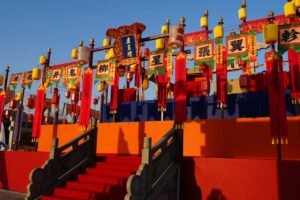
Maoshan and Luo Tian Grand Jiao
Maoshan has a long history of holding the ‘Luo Tian Da Jiao.’ According to the records in the Yuan Dynasty’s ‘Maoshan Zhi,’ in the third year of Jiading (1210) during the Duanwu Festival, Empress Jiading commanded the Left Street Supervisor, Yi Shang, to represent her in person at the Shangqing Ancestral Altar in Maoshan Huayang Cave Heaven. They prepared golden dragons, jade discs, and offerings, worshipping the 34th generation patriarch of Shangqing, Xue Rujia, and seeking acceptance of the ‘Great Cave Bi Fa Bao Lu.’
During this grand event, Maoshan established the Jade Fasting altar for the ‘Luo Tian Da Jiao,’ conducted extensive fasting, and offered feathered garments. According to records, on that night, jade ropes and golden waves shone, auspicious winds and colorful auras filled the palace courtyard. On the next day, cranes and herons soared, dancing in the sky, and rare plants and herbs were produced in the woods. People from all directions came to observe, all deeply respectful.
After this event, Maoshan held various grand ceremonies during the Ming and Qing Dynasties, and in the 1990s, Jiuxiao Wanfu Palace also hosted the ‘Luo Tian Grand Jiao.’
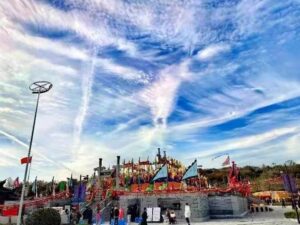

Quanzhen Sect and Luo Tian Da Jiao
The history of the Quanzhen Sect initiating the ‘Luo Tian Da Jiao’ is almost as ancient as the history of the Quanzhen Sect itself. In the early days of the establishment of the Quanzhen Dao, although the Mongol rulers of the Yuan Dynasty were of Mongolian ethnicity, they often held fasting and offering ceremonies according to ancestral traditions, and many large-scale ceremonies were presided over by Quanzhen Daoist priests.
The ‘Ganshui Immortal Source Record’ recorded that Li Daoqian held the ‘Luo Tian Da Jiao’ multiple times. Feng Zhiheng’s ‘Imperial Decree to Establish the Universal Yellow Fasting Monument’ recorded that Emperor Xianzong of the Yuan Dynasty issued a decree for Daoist Wang Zhitant to invite the then ‘Quanzhen Head Master’ Li Zhichang to preside over the ceremony. The scale of the ceremony was even more extensive, with a ritual for three thousand six hundred deities. At that time, it was a flourishing era, and the event took place from the 9th to the 16th day of the third month of the spring of the year Jiayin. The decree instructed the cessation of slaughter, the prohibition of crimes and filth, and the supply of five hundred and eighty taels of gold, three thousand eight hundred taels of silver, and a thousand pieces of colored silk for the ritual. The rest was provided from the state treasury to avoid disturbing the people. The ceremony lasted for seven days and nights, with royal edicts, jade scrolls, and high-ranking officials from various disciplines, Daoist practitioners, and ordinary people all gathered in temples, military camps, and civilian homes, setting up incense and candles in the courtyard. This was a concerted effort throughout the country, showcasing the grandeur of the ‘Luo Tian Da Jiao.’
The “Ruihe Zan” recorded in the “Dao Yuan Xue Gu Lu” states that in the third year of the Zhi Shun era of the Yuan Dynasty (1332), in the month of March, the emperor and empress specially appointed the “Divine Grand Master” Miao Dao Yi to conduct a “Heavenly Ritual” at the “Da Changchun Palace” (now Baiyun Guan in Beijing). During the ritual, blue phoenixes and white cranes danced in the air above the altar, melodious calls echoed, and they circled in the sky, signifying an auspicious response.
Regulations for the 2023 Luo Tian Grand Jiao
This grand ritual, coinciding with the thirtieth anniversary of the restoration of the Qianyuan Temple, is organized by the Chinese Taoist Association and hosted by the Maoshan Qianyuan Temple. It sincerely invites eminent Taoist masters, experts, and scholars from both domestic and international realms, along with 16 legal affairs groups from around the world, to jointly establish supreme virtuous causes.
Following the ceremonial standards of “Lingbao Lingjiao Jidu Jindu Jinshu,” “Supreme Yellow Register Great Fasting,” “Daoist Customization,” and others, the reconstruction includes the establishment of a three-tiered “Xuhuang Altar,” consisting of Inner Altar, Middle Altar, and Outer Altar.
The Inner Altar is equipped with ten gates, each dedicated to the ten directions of the Supreme Lingbao Celestial Venerables. Within the altar, three tiers of platforms are erected to welcome the “Supreme Infinite Dao,” the “Thirty-Six Honored Sutras,” and the “Great Master of Mystery,” along with the “Heavenly Ritual for Twelve Hundred Holy Seats.” On the sides are arranged sun and moon lamps, golden bells, jade chimes, prohibition plaques for the altar, demon-commanding banners, and anti-evil flags, among others.
The three-tier Xuhuang Altar follows the ancient method of Master Duguangting, symbolizing the positioning of the three talents of heaven, earth, and humanity. According to Daoist beliefs, this altar directly connects to the heavenly realms and serves as the channel through which high-ranking immortals from the Three Bureaus and Twelve Hundred Holy Venerables descend. It is also the sacred altar for conducting important rituals during the three temporal divisions, offering sacrifices, reciting praises, worshiping stars, presenting memorials, and more.
In continuation of tradition and following the ancient practices outlined in the “Lingbao Yujian” and “Lingbao Lingjiao Jidu Jindu Jinshu,” there are designated halls for silent contemplation, profound thoughts, mystery, celestial masters, meal supervision, the Five Elders, the Three Officials, meal supervision again, the control of the City God and the patrol guardian Liu Yuanshuai’s divine seat. There is also the “Capital Altar” (located in the Jade Emperor Hall, serving as the main altar indoors for the grand ritual, dedicated to the Twelve Hundred Holy Seats), along with the Grand Altar, Imperial Scripture Altar, Salvation Altar, Jade Shu Altar, Three Yuan Altar, Thanksgiving Altar, Shunxing Altar, various True Altars, Lifespan Extension Altar, Taiyuan Altar, Universal Salvation Altar, Demon Suppression Altar, and Qingxuan Altar, totaling fourteen officiating altars. These are specifically used for reciting specific scriptures and repentance to eliminate faults, seek forgiveness, accumulate blessings, and welcome auspiciousness.
In this prosperous era, the grand reconstruction of the “Blessing the Country, Welcoming Auspiciousness, Prolonging Joy, and Universal Salvation Heavenly Ritual” by Maoshan Qianyuan Temple aims to “harmonize heaven and earth, safeguard the country and bring peace to the family.” Against the backdrop of the “unprecedented major changes of the century,” it seeks to fulfill our societal mission and compassionate care for life through devout ceremonies. May this solemn act of virtue bless society with prosperity, favorable weather, national stability, and further hope for the great rejuvenation of the Chinese nation, as well as peace and stability worldwide.
Written and Translated by Daoist Liu Cheng Yong, German Daoist Association.

